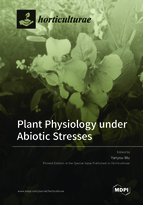Plant Physiology under Abiotic Stresses
A special issue of Horticulturae (ISSN 2311-7524). This special issue belongs to the section "Biotic and Abiotic Stress".
Deadline for manuscript submissions: closed (30 November 2022) | Viewed by 31499
Special Issue Editor
Interests: stress physiology; photosynthesis; water metabolism; electrophysiology
Special Issues, Collections and Topics in MDPI journals
Special Issue Information
Dear Colleagues,
Abiotic stress includes not only single adversities, i.e., drought, temperature, light, salt, nutrient, heavy metal, but also complex stresses, i.e., karst environment, saline–alkali soil, wetland environment. Abiotic stresses strongly affect many aspects of plant substance and energy metabolism. Meanwhile, abiotic stress not only affects the physiological processes of photosynthesis, water metabolism, and inorganic nutrient absorption, but also influences the electrophysiology and other physical parameters of plants. Therefore, their gene expression, electrophysiology, leaf mechanics, and carbon and nitrogen assimilation will respond and change correspondingly. The rapid determination of plant physiological information under adversity is meaningful to the real-time regulation of plant growth and development. Plant physiological information under adversity, especially the online physiological information, helps us to understand the plant adaptive mechanism. This current Special Issue will involve work regarding plants’ adaptability to abiotic stresses. Scientists from all over the world are invited to submit original research and review articles that relate to such topics.
Prof. Dr. Yanyou Wu
Guest Editor
Manuscript Submission Information
Manuscripts should be submitted online at www.mdpi.com by registering and logging in to this website. Once you are registered, click here to go to the submission form. Manuscripts can be submitted until the deadline. All submissions that pass pre-check are peer-reviewed. Accepted papers will be published continuously in the journal (as soon as accepted) and will be listed together on the special issue website. Research articles, review articles as well as short communications are invited. For planned papers, a title and short abstract (about 100 words) can be sent to the Editorial Office for announcement on this website.
Submitted manuscripts should not have been published previously, nor be under consideration for publication elsewhere (except conference proceedings papers). All manuscripts are thoroughly refereed through a single-blind peer-review process. A guide for authors and other relevant information for submission of manuscripts is available on the Instructions for Authors page. Horticulturae is an international peer-reviewed open access monthly journal published by MDPI.
Please visit the Instructions for Authors page before submitting a manuscript. The Article Processing Charge (APC) for publication in this open access journal is 2200 CHF (Swiss Francs). Submitted papers should be well formatted and use good English. Authors may use MDPI's English editing service prior to publication or during author revisions.
Keywords
- electrophysiological
- photosynthesis
- biophysics
- adaptation mechanisms
- plant tolerance
- horticulture
- drought stress
- chilling injury
- nutrient deficit
- salt stress






